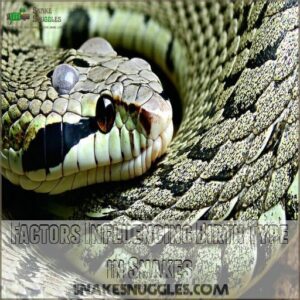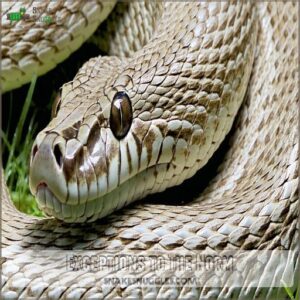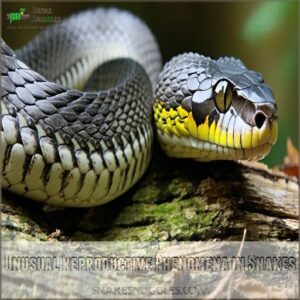This site is supported by our readers. We may earn a commission, at no cost to you, if you purchase through links.

While about 70% of snake species are oviparous and do lay eggs with leathery shells, the rest take a different path.
Some snakes are viviparous, meaning they give birth to live young, much like a lizard rock star skipping the egg phase.
Others, known as ovoviviparous snakes, hatch their eggs internally, sneaking their babies out fully formed.
Such adaptations often depend on climate and survival strategies.
Curious about how these methods vary across snake families or climates? There’s a whole world of reptilian reproduction waiting to be discovered!
Table Of Contents
Key Takeaways
- Not all snakes lay eggs; about 30% give birth to live young, either through viviparity or ovoviviparity, depending on their environment and survival needs.
- Oviparous snakes, like ball pythons, lay eggs with soft, leathery shells, whereas viviparous species, like boas, nourish their young internally until birth.
- Adaptations to climate influence whether a snake lays eggs or gives live birth, with colder climates favoring live birth to avoid egg exposure risks.
- Species such as copperheads and rattlesnakes show ovoviviparous reproduction, where eggs hatch inside the mother before giving birth to live offspring.
Do All Snakes Lay Eggs?
Not all snakes lay eggs.
Imagine this: while many snakes, proudly oviparous, do lay eggs, others break that mold.
Approximately 70% of snake species, such as ball pythons and kingsnakes, are oviparous, with fascinating egg-laying habits.
Viviparous snakes, like boa constrictors, take another route.
They bring live young into the world, skipping the whole egg-laying business.
Then there are the ovoviviparous rattlesnakes, offering a more secretive gestation, where eggs hatch inside, leading to a live birth.
This lively variance showcases snakes’ adaptability, catering to their habitats and boosting those survival odds.
If you’re diving into snake reproduction, these distinctions offer a fascinating peek into nature’s ingenuity.
Who knew these slinkers had such diverse parenting styles?
Keep curious—it’s the key to understanding these scaly wonders.
Oviparity in Snakes
Ever wonder how snakes reproduce? Many snakes lay eggs, a process called oviparity.
Imagine this: a mother snake carefully chooses a safe spot, maybe under a rock or in a cozy burrow, then deposits her clutch of eggs. These aren’t your typical hard-shelled chicken eggs; snake eggs have soft, leathery shells, often white or off-white. You might even find snake eggs for sale online, though they probably aren’t the kind you’d want to eat!
The number of eggs, or clutch size, varies widely depending on the snake species. After laying the eggs, Mom’s job is done; she doesn’t stick around to care for them.
Egg incubation takes time – usually 45 to 70 days – and the temperature and humidity need to be just right. During this period, the eggs face threats like egg predation from hungry animals.
Once hatched, the baby snakes are totally independent. So, while egg-laying is a common snake strategy, it’s far from the only way these amazing creatures reproduce.
Viviparity and Ovoviviparity in Snakes
Exploring the fascinating world of snakes, you’ll find that not all squamates lay eggs. Around 30% of them are viviparous, giving birth to live young.
This unique strategy, viviparity, involves nourishing embryos inside the mother.
For snake enthusiasts and breeders, understanding snake reproduction is key, which is why products for snake reproduction supplies can be really helpful.
Then, there’s ovoviviparity, where eggs develop internally and hatch just in time for a dramatic entrance into the world.
Picture rattlesnakes and certain vipers and boas doing just that.
This adaptability gives these snakes a leg—or rather, a coil—up in colder climates where egg-laying isn’t practical.
With internal development, these snakes enjoy benefits like reduced sibling competition and enhanced genetic diversity.
It’s a quirky yet remarkable method that highlights how snakes master their environment.
Factors Influencing Birth Type in Snakes
Understanding why some snakes lay eggs while others give birth to live young involves examining climate adaptations, evolutionary advantages, and family variations.
It’s like choosing the best coat for the weather—these birth types help snakes thrive in diverse environments.
Climate Adaptations
Snakes are quite the clever adapters, tailoring their reproductive strategies to match the climate.
In colder or drier regions, you’ll often find viviparous and ovoviviparous snakes like boas thriving by giving live birth, which helps them sidestep risks like dried or frozen eggs.
For example, tropical sea snakes also give birth in water, while the oviparous green tree python is perfectly at home in rainforests.
Temperature tolerance, seasonal breeding, and habitat selection are key to these climate-driven reproductive choices.
Whether they’re hanging out in scorching deserts or lush rainforests, snakes know how to pick the right birth mode for their environment.
Evolutionary Advantages
In the realm of snake reproduction, the evolutionary advantages are as varied as the snakes themselves.
Different reproductive strategies—oviparous, viviparous, and ovoviviparous—boost genetic diversity and improve survival rates, especially as certain species like copperheads and pythons reproductive strategies lay eggs or give birth to live young.
These tactics help snakes exploit niches, avoid predators, and manage resource competition.
By enhancing evolutionary fitness, snakes promote their ability to thrive in diverse environments, showing a knack for survival.
Family Variations
Many snake families exhibit diverse reproductive strategies.
Boidae, often ovoviviparous, adapt to dry climates with live birth.
Pythonidae, conversely, are entirely oviparous.
Green Tree Pythons and Emerald Tree Boas demonstrate parallel evolution in reproduction.
Family lineage strongly influences breeding patterns.
Geographic distribution and climate also play a role in determining whether a snake species is oviparous, viviparous, or ovoviviparous.
Exceptions to The Norm
You might wonder, do all snakes actually fit the mold in terms of reproduction?
For sea snakes, laying eggs isn’t always on the agenda—most are viviparous, giving birth to live young right in the water, bypassing land altogether.
Snake enthusiasts can even find viviparous snake supplies online for their pets, such as on websites that sell products for viviparous snakes (viviparous snake supplies).
Meanwhile, the mighty king cobra defies stereotypes by constructing nests for its eggs, uncommon among its serpentine peers.
Even within venomous snakes, it’s a mixed bag: rattlesnakes hatch inside, emerging live through ovoviviparous methods.
There’s something charmingly unpredictable about snakes that sidestep the norm, like a snake blending exceptions with mystery.
This intriguing variation highlights nature’s adaptability, making each species an expert at surviving in its own unique way, whether sheltered by nests or set adrift in ocean currents.
Unusual Reproductive Phenomena in Snakes
How do snakes break the mold of typical reproduction? One fascinating phenomenon is parthenogenesis or “virgin birth.” Imagine a female boa constrictor reproducing without a male, creating offspring that are clones of herself. This trick isn’t just sci-fi; it’s part of broader strategies in snake species.
Hybridization can alter venom, impacting survival; and endoparasitism can tweak reproductive success.
Additionally, the evolution of viviparity is important in chillier climates, ensuring live births during harsh conditions. Even venom varies, boosting hunting efficiency across ecological niches.
These quirks in snake reproductive methods, like delayed fertilization or even the rare twin births, show just how resourceful and adaptable these creatures can be.
Exotic Pet Trade and Snakes
Caught up in the allure of unique pets, the exotic pet trade affects snake welfare and conservation.
Snakes make up a hefty slice of this market.
Unfortunately, misconceptions about reptiles can lead to neglect and high mortality rates. Picture a cramped, poorly ventilated box for days—some snakes don’t make it.
To address these issues, some breeders have found success in breeding popular species, such as corn snakes and royal snakes, which are in high demand and can be quite profitable.
This trade can also impact wild populations, driving illegal capture and dwindling biodiversity.
To tackle these challenges, ethical considerations are key, from sustainable practices to captive breeding.
While legal regulations aim to protect them, it’s often a bumpy road.
Understanding snake reproduction—whether they’re oviparous, viviparous, or ovoviviparous—can guide better breeding practices and make sure these fascinating creatures thrive.
Frequently Asked Questions (FAQs)
Do sea snakes lay eggs?
Most sea snakes give birth to live young in the water.
Laticauda genus sea snakes lay eggs on land.
So, while many sea snakes don’t lay eggs, some take the terrestrial route.
Do snakes lay eggs or give birth?
Snakes employ diverse reproductive strategies. Some lay eggs (oviparity), others give birth to live young (viviparity), and a few retain eggs internally until hatching (ovoviviparity). It’s a varied world!
Do snakes have oblong eggs?
Snake eggs are indeed oblong, typically elongated, and have soft, leathery shells.
You’ll often find them laid close together in groups.
Remember, not all snakes lay eggs; some give live birth instead.
How long do snakes lay eggs?
You might wonder how long snakes lay eggs.
While it varies, snakes typically lay eggs over a few hours to several days, depending on species.
It’s like a reptilian marathon, with each clutch differing in size.
Do snakes lay eggs outside the body?
Not all snakes lay eggs outside their bodies.
While many do, like rat snakes and cobras, some give birth to live young instead.
Rattlesnakes, for instance, have a unique approach, retaining eggs internally until hatching.
Do snakes hatch from eggs?
Snakes hatch from eggs or are born live, depending on the species.
While many snakes lay eggs, some give birth to live young.
Though hatchlings emerge ready to fend for themselves, you might feel surprised by their independence!
What kind of snake does not lay eggs?
Some snakes don’t lay eggs; instead, they give birth to live young.
Viviparous snakes, like boa constrictors and green anacondas, nurture their babies inside until they’re ready for the world, skipping the eggs entirely.
Do copperhead snakes lay eggs?
Copperheads are ovoviviparous, meaning they don’t lay eggs; instead, they give birth to live young. These little snakes are born ready to strike, just like their parents!
Do rattlesnakes lay eggs?
Rattlesnakes don’t lay eggs.
Instead, they give birth to live young, known as ovoviviparity.
Baby rattlers come fully equipped with fangs and venom, adding a thrilling edge to their entrance into the world.
Do garter snakes lay eggs?
Garter snakes don’t lay eggs.
Instead, they give birth to live young, much like a tiny maternity ward in nature.
It’s a neat twist, letting baby snakes skip the whole egg-hatching routine entirely.
Conclusion
Who knew snake reproduction could be so complex?
Contrary to popular belief, not all snakes lay eggs.
With some ditching the egg phase altogether, you’ve got a fascinating mix of reproductive methods, thanks to climate and evolutionary quirks.
These amazing adaptations highlight nature’s creativity, whether it’s viviparous live births or sneaky ovoviviparous hatchings.
Understanding these varied snake strategies brings the vibrant world of reptilian reproduction to life.
So, next time someone asks, "Do all snakes lay eggs?" you’ll know the surprising truth!










